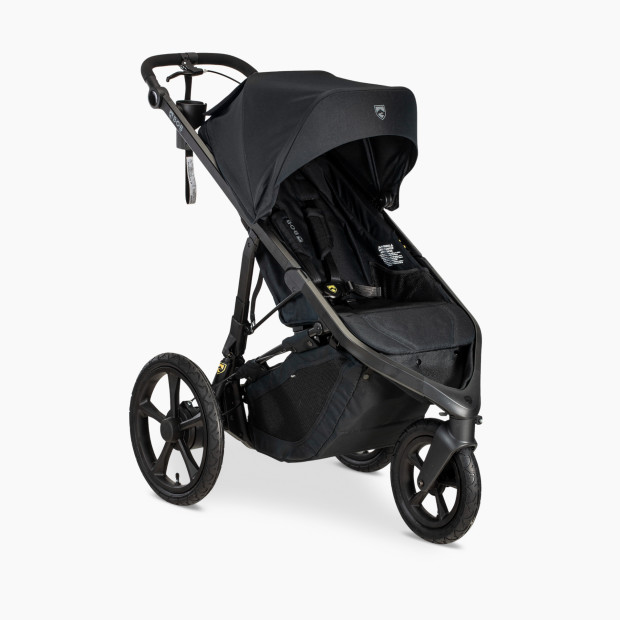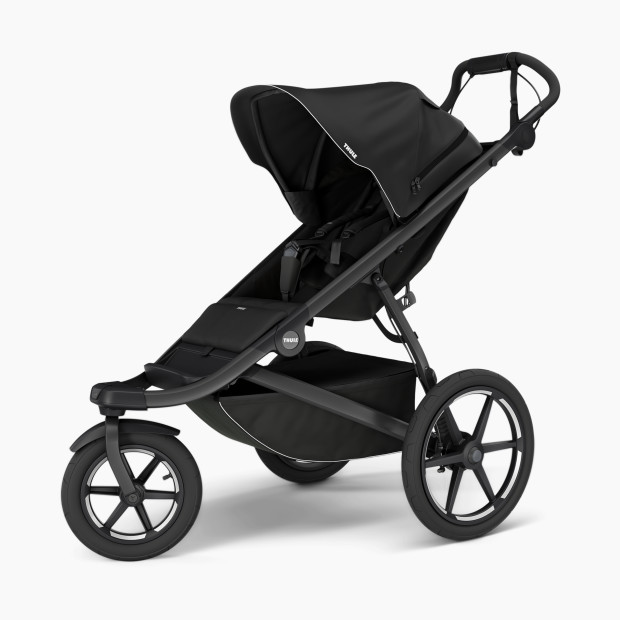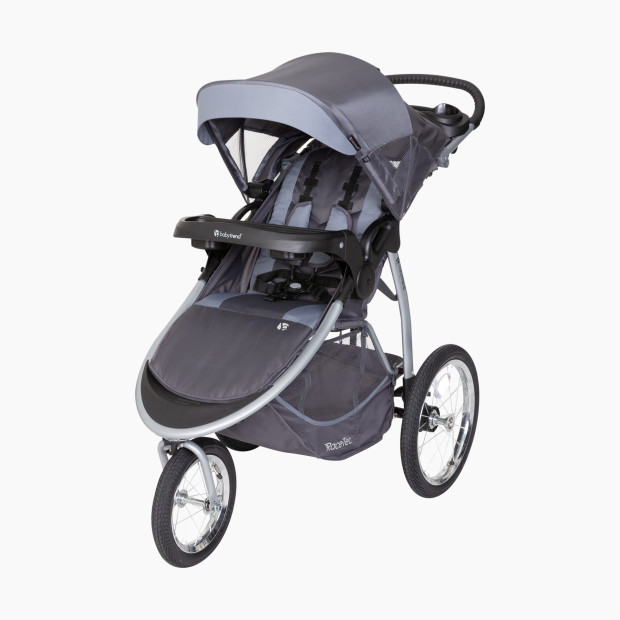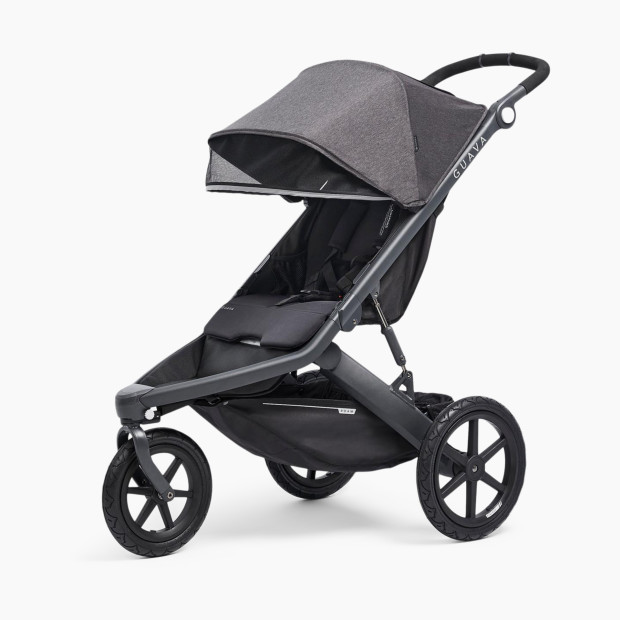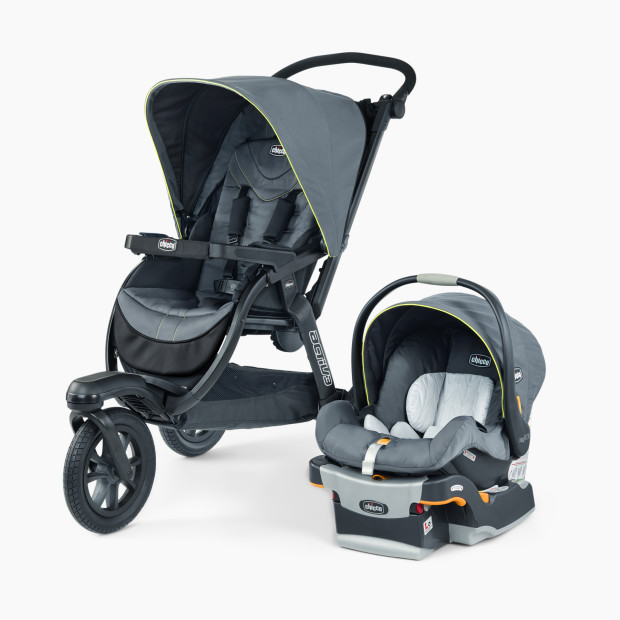
Best Jogging Strollers of 2025, According to a Gear Expert, Runner and Mom
Love to run? You don’t have to stop. The right jogging stroller can help keep you rolling.

By Jen LaBracio, CPST
In This Article
Before I had kids, I loved to run. I lived in New York City at the time, right near Central Park, and nothing cleared my head better than a run (er, jog?) on my favorite route. Then I got pregnant, ended up on bed rest, and wondered if I’d ever run again.
Fast-forward to a few months postpartum when I snagged a used jogging stroller from a local parent group on a whim—and I am so happy I did. Running made me feel like my old self again. Even getting out the door for a long walk with my jogger helped. It was just one item of baby gear, but it made a huge difference.
Jogging strollers are built differently than traditional strollers. They’re a must-have if you’re a regular runner. “Since becoming a mom, stroller running has been a BIG part of my training,” says Kaitlin Goodman, a former professional distance runner and member of Team USA, running coach and founder of Running Joyfully. “I estimate that I log about one-quarter to one-third of my miles with the stroller.” But even if you’re not Olympic-bound (🙋🏻♀️), you’ll want to consider a jogger if you plan to walk regularly with your baby or if your daily route involves dirty roads, bumpy surfaces or other off-the-beaten-path terrain. And since running strollers are an investment, it’s important to know how different models perform, which ones hold up the best as you continue to log miles and what features to look for.
After dozens of fast walks, slow runs and everything in between, we think the BOB Gear Wayfinder is the best jogging stroller for most runners and walkers. The Thule Urban Glide 3 is a very close second, however, earning an honorable mention spot. And we chose three other picks if you’re looking for a different option, such as a more affordable pick or a hybrid you can use for both everyday and exercise.
Why Trust Babylist?
Babylist is the expert in baby; we know baby gear inside and out. We talk with parents face-to-face in our showroom and on our user panels and hear from thousands annually via our Best Baby Products online survey. We know what items millions of expecting parents are adding to their baby registries.
I’m Babylist’s gear editor, a mom of two and a runner. I’ve run through city streets and parks, in suburban neighborhoods and on gravel paths, and even ran a marathon. (It was a long time ago, but that’s a timeless brag I'll never let go.) And on many of these runs, I’ve brought my kids along. I’ve personally owned four different jogging strollers over the years and have tested many more. And for an expert perspective, I turned to one of the most inspiring running moms around: coach, former pro distance runner and former Team USA member Kaitlin Goodman, founder of Running Joyfully. I also analyzed data from Babylist’s annual Best Baby Products survey of thousands of Babylist users and got feedback from parents and fellow runners on the Babylist team.
How We Judged the Best Jogging Strollers
Best Jogging Stroller Overall
BOB Gear Wayfinder Single Jogging Stroller - Nightfall
From $463.99Pros
- Narrower and more compact than most joggers
- Independent dual suspension
- High weight limit of 75 lbs
Cons
- Heavy
- Higher, slimmer profile takes some getting used to
- Air tires = great for suspension but risk of a flat
Ask any running parent if they’ve heard of or owned a BOB stroller and the answer will likely be a resounding yes. BOBs are a longtime favorite of the running community thanks to their durability, incredible suspension system and a long list of convenient features. (“Smooth as a Cadillac,” said one parent in our Best Baby Products survey!) The Wayfinder, the brand’s newest addition, is a home run. While there are a few small drawbacks, the overall functionality, performance and profile make this stroller the best choice for frequent runners or for any parent who’s regularly traversing uneven terrain.
The Wayfinder features independent, dual suspension and air-filled tires, so no matter what type of terrain I tried (dirt path, sandy road, bumpy sidewalk), it provided a smooth ride all the time. It checks the boxes of must-have features I look for in a jogger: a swivel-locking front wheel, a hand brake, a wrist strap, an adjustable handlebar and a large cargo basket. The fabrics and finishes look and feel high-end, there’s a great canopy and the seat reclines all the way back. And it’s compatible with many popular infant car seats with the addition of adapters.
What pushes the Wayfinder to the front of the line in my eyes, though, is its slimmed-down profile. While not small by any means (it’s actually a few pounds heavier than some similar joggers), this jogging stroller is narrower and more compact all around than many of its competitors. And when you fold it (which is also easy to do, btw), it gets even smaller; the Wayfinder is only about 22 inches across when folded, making it a lot easier to store or get into your trunk than other similar joggers I’ve tried.
It’s worth noting that the narrower profile of this jogger did take a little getting used to at first. Since I was accustomed to a wider, longer jogging stroller, the Wayfinder felt a little “tall and skinny” to me, for lack of a better descriptor. I had to be more careful taking tighter turns as it felt like it was a bit less reactive than my previous jogger. However, once I got used to the stroller’s profile, this feeling went away, and I really enjoyed running with it.
The weight is also something to consider. Most joggers clock in around 25 pounds, but the Wayfinder is almost 32. Since this stroller primarily lived in my garage, this wasn’t a concern for me, but if you’re looking for something you’ll need to hoist in and out of your car on a regular basis, the Wayfinder may not be the best choice. “Many of the athletes I coach as well as friends have [a] BOB stroller, which also came highly recommended to me,” Goodman told me. “BOB is a workhorse and handles well on router terrain…[But] for us, the weight of the BOB was a reason to go with the Thule instead.”
And speaking of weight, BOB also advertises the Wayfinder’s higher weight limit of 75 pounds. But the jogger’s height limit is 44 inches so, much like an infant car seat, the odds are pretty high that your little one will grow out of it height-wise long before they ever come close to the stroller’s max weight capacity.
If you’re not sold on the Wayfinder and want to stick to one of the brand’s tried and true classics, check out the Revolution Flex 3.0.
Additional Specs
Stroller Weight: 31.1 lbs
Age Range: From birth with an infant car seat and adapter; up to 75 lbs or 44”. Use only with an infant car seat until child has sufficient head and neck control, approx 6 mos.
Honorable Mention
Thule Urban Glide 3 - Black
From $649.95Pros
- Excellent suspension and maneuverability
- More upright seat than 2nd gen
- Good ventilation, high-quality fabrics
Cons
- Storage basket is tough to access
- Self-standing fold is tricky
- Expensive
While BOB has dominated the jogging stroller market in the past, Thule is quickly becoming a newer favorite among both casual and more serious running parents. Goodman named the Urban Glide 2, the previous generation of this popular stroller, as her favorite. “I wanted something that was built for serious running as I knew I'd be logging many miles postpartum with my kiddo due to balancing running goals and the amount of childcare we have,” she explains. “It’s a smooth ride for my kiddo and easy for me to push.”
The brand’s newest release, the Urban Glide 3, builds on the features runners loved about the Gen 2. It’s an excellent running stroller. It’s also streamlined and nimble enough to navigate urban settings if need be. “It works in every situation,” one parent told us. “And is durable but sleek.”
The first thing I noticed about the third generation of this popular stroller is just how easy it is to push. Babylist parents agree, with one Best Baby Gear survey respondent saying, “It handles like a dream.” Weighing in at almost seven pounds less than the BOB Wayfinder, it’s a true pleasure to run with. It’s also easier to navigate in everyday life. “The lighter weight is helpful in lugging the stroller in and out of the car,” said Goodman. “It's much lighter than a BOB I tested [which I] found difficult to lift and to fit in my SUV trunk.”
The Urban Glide is longer front to back than the Wayfinder, making even tight turns a breeze. The large rear wheels and all-wheel suspension provided a smooth ride both on and off-road, and the handlebar twist break was easy to operate and control, even on steep downhills. “I live in a hilly area and while I try to avoid running on the hills with the stroller since that is so challenging, I utilize these added safety features when walking up and down Seattle's steep hills with the stroller,” says Goodman. There’s a locking front wheel, too.
Everything about this stroller screams high-end, including the beautiful fabrics, all-around ventilation panels, large, extendable canopy and one-handed recline. And speaking of reclines, a common complaint about older generations of the Urban Glide was that even the highest seat recline position still leaned babies back too far. Thule heard the feedback and updated the 3.0 with a much-improved (and much more upright) seat back position. Some parents still wish it was a bit more upright, but I haven’t had an issue; even my extra-curious toddler was comfortable riding in it while simultaneously taking in the scenery whizzing by.
The Urban Glide 3 is compatible with many top-rated infant car seats from major brands, and can also be paired with the Thule Bassinet. The one-handed fold takes a few tries to master but it’s then smooth sailing. Other notable features I liked include the multi-position canopy and the adjustable handlebar.
Something I didn’t love: the storage basket has a weatherproof covering, which is great if you run into some rain while you’re out jogging, but can be hard to get your diaper bag in and out of. I also found the self-standing fold to be tricky, and my (many) tries resulted in a fairly scraped-up handlebar.
If you’re comparison shopping, it’s also worth noting that I tested another jogging stroller in a similar price bracket as the Wayfinder and the Urban Glide 3, Baby Jogger’s Summit X3 Single Jogging Stroller. I mostly liked it; it was easy to push and steer and it performed well over varied terrain. But I didn’t like the awkward position of the handbrake at all, and I felt the suspension was lacking as compared to the BOB and Thule joggers. The seat is also on the shorter side; my tall two-year-old’s head was pretty close to touching the top of the stroller’s back. Some users also complain of issues with the front wheel, which I did not experience.
Additional Specs
Stroller Weight: 26.2 lbs
Age Range: From birth with an infant car seat and adapter; up to 50 lbs. Use only with an infant car seat until child has sufficient head and neck control, approx 6 mos.
Best Affordable Jogging Stroller
Baby Trend Expedition Race Tec Jogger Stroller - Ultra Grey
From $129.99Pros
- Well priced
- Parent console and child snack tray included
- Large storage basket
Cons
- Only for occasional jogs, not regular runs
- Handlebar is not adjustable
- Low height maximum
Jogging strollers come at a hefty cost. If you don’t want to invest in something you’re unsure you’ll use often, or if you simply want to keep the cost down, the Baby Trend Expedition is a good choice. At under $200, it shares similar features with much more expensive joggers, like XL tires and a lockable front wheel, but at a much more budget-friendly price.
This jogger has a spacious storage basket, a feature I think is essential. Both child and parent trays are included, a nice perk for such an affordable jogger. And the seat reclines for naps on the go. It’s also compatible with certain Baby Trend infant car seats, so you can use it from day one if you’d like.
This jogging stroller is designed for occasional, casual jogs, not regular, serious running. And while it does handle well on smooth pavement and slightly uneven terrain, it’s not meant for hardcore off-roading as it lacks the shocks and the sling-style seat needed to absorb lots of bumping around. It also has a lower height maximum when compared to other jogging strollers.
Additional Specs
Stroller Weight: 31.1 lbs
Age Range: From birth with a Baby Trend car seat (does not accept other car seat brands); up to 50 lbs or 42”. Use only with an infant car seat until child has sufficient head and neck control, approx 6 mos.
Best Hybrid Jogging Stroller
Guava Family Roam Crossover Stroller
From $549.95Pros
- Works for jogging or as an everyday stroller
- Folds 50% smaller than traditional joggers
- Quick, easy fold
Cons
- Less suspension than traditional joggers
- Not ideal for very frequent runners
- Foam-filled tires = less suspension but no flats
When I had my second baby, I needed a new stroller. I knew I wanted to jog with him, but I also knew I’d be in and out of my car with my older child and didn’t want to deal with the hassle of wrangling a full-size, 30+ pound jogging stroller every time. Enter the perfect solution: the Guava Roam.
The Roam is the perfect hybrid, a mash-up of a traditional and a jogger-style stroller. “It’s truly the most durable, versatile, all-around stroller,” a Best Baby Products survey respondent told us. It combines everything you love about a jogging stroller—independent suspension, XL tires, a locking front swivel wheel—at 50% of the size of more traditional joggers. It’s just as easy to toss in your trunk as it is to take on a three-mile run. The fold is quick and effortless and it’s packed with other thoughtful features like an adjustable handlebar, near-flat recline, infant car seat add-on capability, ventilation and a peek-a-boo window.
“We SWEAR by the Guava Roam stroller,” said another parent. “It’s very durable and provides a jogging stroller option which is great (even if you don’t jog!!) with airless wheels. Very sturdy. But EASILY folds up and travels well. All other jogging strollers are very difficult to travel with. We love love love the Guava Roam.”
If I was someone who ran multiple miles a week, week in and week out, I’d have likely opted for a BOB or a Thule. But, I am most definitely not—so this stroller satisfied my needs perfectly. And while the canopy is big, it could be bigger to provide more shade and coverage. And there’s no hand brake.
Additional Specs
Stroller Weight: 25 lbs
Age Range: From birth with an infant car seat and adapter; up to 60 lbs. Use only with an infant car seat until child has sufficient head and neck control, approx 6 mos.
Best Jogging Stroller Travel System
Chicco Activ3 Jogging Travel System - Solar
From $399.00Pros
- Good value (includes infant car seat)
- Adjustable suspension
- Control console
Cons
- Foam tires = bumpier ride
- Small storage basket
- Bulky when folded
Finding a high-quality jogging stroller at an affordable price can be tricky. To hold up to hundreds of miles and handle all types of terrain, joggers require specific, high-end components and fabrics—and high-end often equals a high price. Chicco’s Activ3 jogger sits at a more palatable price point than our BOB and Thule picks, and, while it’s not my first choice for a runner who regularly runs long distances, it’s a solid mid-level option to consider if you don’t want to spend $500+ and if you want to limit decision fatigue by investing in a stroller and a car seat combo. (This listing is for the travel system version of the jogger, so it includes an infant car seat, but the stroller is available solo for $349.)
A few things stand out about this jogging stroller, including the adjustable suspension and the control console. If you’re using the jogger on uneven terrain, you can adjust the suspension on each back wheel to make the ride less bumpy on dirt or gravel. Suspension isn’t something you’ll find on most less expensive jogging strollers, so it’s a big plus here. There’s also something called a Control Console—two buttons located on each side of the handlebar that trigger the stroller’s parking break and the front wheel swivel. We love how easy they are to access.
This travel system pairs the jogger with the popular KeyFit30 infant car seat, one of my go-to car seat recs. Other features parents rave about are the height-adjustable handle, the seat angle (the Activ3 offers a more upright seat position than many other joggers) and the extendable canopy. The foam-filled tires aren’t quite as cushy as air-filled, but require less maintenance. The stroller’s cargo basket is small and the stroller is pretty bulky when folded unless you pop off the wheels each time.
Additional Specs
Stroller Weight: 31.1 lbs
Age Range: From birth with a Chicco KeyFit car seat (does not accept other brands); up to 50 lbs. Use only with an infant car seat until child has sufficient head and neck control, approx 6 mos.
How We Chose the Best Jogging Strollers
We analyzed results from Babylist’s Best Baby Products survey, which polled 6,000 Babylist users and asked them to share the baby products they love the most and why.
We utilized insight from the Babylist editorial team, including me, Gear Editor Jen LaBracio, an expert in the baby space for over six years, mom of two and a runner who has written hundreds of baby gear guides and personally researched and tested hundreds of baby products, including many jogging strollers.
We spoke to Kaitlin Goodman, a former professional distance runner and member of Team USA, running coach and founder of Running Joyfully.
We read customer reviews from hundreds of Babylist users and spoke to parents on our Babylist staff about their real-life product experiences.
Do You Need a Jogging Stroller?
If you’re walking mostly indoors or on smooth pavement, a traditional stroller is all most families will need. But if you plan to run or jog, or frequently walk along uneven terrain (think a dirt or sand path, gravel road, etc.) a jogging stroller is a must-have.
Why can’t you jog with a regular stroller?
Jogging strollers are made to absorb the bouncing that comes along with more intense speeds or uneven surfaces. While many traditional strollers offer a pretty smooth ride, joggers have three oversized wheels in a triangle configuration to help glide over rough surfaces and a hefty suspension system that’s designed specifically to decrease the impact of jolts on your baby.
Jogging strollers have one other major differentiator: locking front wheels. Unlike everyday strollers that have swiveling front wheels, running strollers have a setting that locks the stroller’s front wheel in place. This keeps you on course while running and prevents the front wheel from wobbling—and eventually crashing—when you’re moving at faster speeds. Many joggers also have hand breaks so you can stop quickly if needed.
Keep in mind: while traditional strollers can’t be used for running or jogging, most jogging strollers can double as everyday strollers for some families, as long as you have the space for one.
When Is It Safe to Start Jogging with a Baby?
It’s not safe to run or jog with your baby until they have strong head and neck control, which usually happens around the six- to eight-month mark for most babies. That’s because as your baby gains full control of their head and neck, they’ll be able to keep their bodies more stable under the impact of the jolts and bounces that come along with running.
“I waited the recommended amount of time (six months) to start running with my kiddo, waiting until he had good head control,” explains Goodman. “At first I ran about once a week with him, and as he's gotten older/when I am in marathon training, I do about one-third of my mileage with the stroller as I balance running, childcare hours and co-parenting with my partner.”
If your jogging stroller accepts an infant car seat, you can use it from day one for walks, but not for running. Once you are able to get moving, you’ll get many years out of your jogging stroller—many accommodate children up to four or five years old.
How to Choose a Jogging Stroller
When researching jogging strollers, consider two things: your lifestyle and the stroller’s specific features.
From a lifestyle perspective, think about how you see yourself using a jogging stroller.
Are you planning on mostly running or walking with your stroller? How often? And how many miles at a time? All jogging strollers are designed to provide more stability than a traditional stroller, but they vary in how many mechanisms they have in place to accomplish this. Some are made for serious running while others are built for a short jog here and there. Thinking through how you’ll use your stroller can help you decide if you need something that can withstand hundreds of miles or one that’s designed more for an occasional light jog or walk.
What type of terrain are you running or walking on? Again, this can help you determine if a jogger with a serious suspension system and oversized, air-filled tires is a must-have or if it’s lower down on your list.
Most running strollers are big and bulky—will you have a place to store one? Check storage space at home and in your vehicle’s trunk if you plan on driving with your stroller.
Features-wise, these are the most important ones to consider:
Locking front wheel. A locking front wheel is critical to a jogging stroller’s stability and safety. Most running strollers have a front wheel that toggles between the swivel and locked position so you can more easily maneuver it when walking but lock it into place when it’s time for a run.
Brakes and safety tether. A handbrake and wrist handle for emergency stops and for slowing down is a jogging stroller must-have, according to Goodman—especially if you live in a hilly area like she does.
Harness. Just like your baby’s car seat, the seat in a jogging stroller should have a five-point harness to keep your child secure.
Canopy and recline. Look for an extra-large canopy to shield your child from the elements. Goodman also recommends a peekaboo window so you can check in on your little one while running. Also, pay attention to how far back the seat reclines. “I like the lay-flat capability of my Thule,” says Goodman. “We've used this when my kiddo falls asleep on the run. Sadly it’s no longer an occurrence at two and a half years, but great when he was younger.”
An adjustable handlebar. If you have a multiple-runner household, this is a nice feature to have so the stroller is comfortable for people of varying heights. “I now put it on the lowest height setting and sometimes my kiddo will push himself!” says Goodman.
Cargo space and accessories. If you’re hoping to stash an extra layer, snacks, a water bottle or anything else while you’re out for a run or walk, consider the amount of storage space under the jogger and whether or not it’s covered. “The Thule has a zip-shut one and my friend's BOB does not, and she's had things fly out of the basket when running,” notes Goodman. Also check out the types of accessories available, like a snack tray or a rain cover.
Weight and portability. Jogging strollers aren’t known to be light, but some are heavier than others. This is important if you run a lot of hills (every ounce matters!) but also if you’ll need to lift your jogger on the regular. Also consider how easy it is (or isn’t) to fold your jogger of choice.
Tips for Running with a Stroller
Like all things in parenthood, running with your little one will take some getting used to. Odds are it will look a little different than it did in your pre-kid days, too. But different doesn’t have to equal worse; you may just have to adjust your expectations a bit.
“A friend advised that once you accept that it's not 'going on a run' but rather 'a mobile field trip,' it's a lot more fun,” says Goodman. “I think this is a helpful reframe for many runners. In my pro running days, I could never imagine stopping for a park break on a run…But now, I just accept that certain training days look like this, and stops and breaks don't stress me out. Rather, it's a fun stroller running adventure with me and my kiddo, checking out a new park or running to the store.” Here are some other tips she recommends to keep running joyfully.
Find a smooth, flat route. “It’s hard to find a rhythm on hilly streets and over bumpy sidewalks, so if you have a bike path near you, opt for that for a smoother ride for you and your kiddo.”
Slow it down. “Pushing a stroller + a child is no easy feat.” Pace yourself.
Pack all the snacks. A packed snack cup (on a strap) is a great running companion.
Run with friends. “My kiddo enjoys when I run with friends and he can listen to our conversation, and he especially likes it when there's another stroller runner and he can run next to a buddy,” she says.
Finish at a park. “My kiddo’s eyes light up when we get to a park.” Run, then play.
When all else fails, sing. Wheels on the Bus, anyone?
